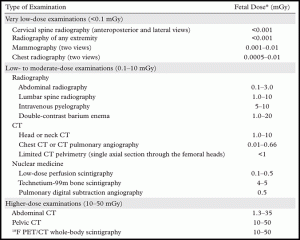Pregnancy & Breastfeeding
OB US
OB US can detect up to 70% of significant abnormalities. Guidelines borrowed from a top practice in Columbia.
9-10 weeks: Dating transvaginal US
12 weeks: Transvaginal ultrasound for nuchal thickening. 1.8 mm or less = decreased risk. 2.5-3 no decreased risk. 3+ increased risk.
20 weeks: Transabdominal morphology scan.
Guidelines for Use of Medical Imaging during Pregnancy and Lactation Radiographics
Breastfeeding and contrast: The dose of iodinated or gadolinium-based contrast medium that reaches the infant through ingestion of breast milk is very small, and only a minute proportion of that which reaches the infant’s gastrointestinal tract is subsequently absorbed. There is insufficient evidence to recommend even a temporary cessation of breast-feeding following the administration of either iodinated or gadolinium-based contrast agents. Because of their higher concentration of free iodide, topical iodine-based disinfectants should be avoided in pregnant and breast-feeding women due to the risk of hypothyroidism in the infant.
Iodinated contrast in pregnancy: Because the fetal thyroid develops throughout pregnancy, any iodine-containing product is contraindicated in pregnant women, given the risk of depression of fetal thyroid function. If iodinated compounds are used in the course of pregnancy, either inadvertently or due to exceptional circumstances, neonatal thyroid function should be checked during the 1st week of life. This testing is already performed routinely for all newborns in North America and Europe. The Committee recommended that iodinated contrast media be used in pregnant women only when (a) no alternative test is available, (b) information to be obtained from the study is useful to both mother and fetus during the pregnancy, and (c) the referring physician considers it imprudent to delay the imaging study until after delivery. If these conditions are met, written informed consent from the parents as to the risks and benefits of the procedure, as well as alternative diagnostic options (when available), are recommended .
Gadolinium in Pregnancy: No known side effects, but due to a lack of long term data it is recommended that imaging be delayed until after pregnancy if possible. If absolutely necessary than informed consent is obtained and the exam can be performed.
Nuclear medicine: If patient is given Tc99m patient should not directly breast feed for 72 hours. Milk should be pumped then frozen/stored. 72 hours after receiving the Tc99m the radioactivity will be essentially gone and the pumped and breast mild are safe to drink. The patient may breastfeed and then pump immediately prior to procedure to have more milk available.
Prepregnancy supplementation recommended for difficulty conceiving:
Folic Acid: 1600 mcg daily
Vitamin D: 2000 IU daily
Omega 3 fish oil: 4 grams daily or DHA/EPA 1200-1500 mg dailiy
Aspirin: 81 mg daily
Imaging in pregnancy:
Xray or CT: Fetal radiation doses up to 1 mGy—used in most radiologic examinations below the knees and above the diaphragm—are considered acceptable, with an additional risk of carcinogenesis of less than one in 10,000. With larger doses (eg, a fetal dose of 20–50 mGy received during pelvic CT), the risk of carcinogenesis increases approximately by a factor of 2, although it remains low in absolute terms (less than one in 250).
MRI: There has been no documented damage to a developing human fetus caused by MR imaging exposure. However, caution is advised, and risks and benefits must always be weighed before evaluating a pregnant patient with MR imaging.
Radiation dose to fetus from various procedures.

